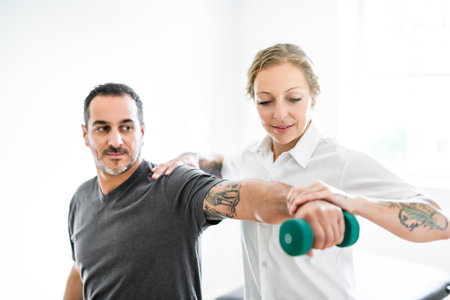1. Understanding Osteoporosis and Its Impact
Osteoporosis is a common condition among older adults in the UK, characterised by weakened bones that are more prone to fractures. As we age, our bone density naturally decreases, but for some people, this process happens more rapidly, leading to osteoporosis. The effects of this condition can be significant, ranging from increased risk of falls and broken bones to a reduction in mobility and confidence. Many older adults find that osteoporosis not only affects their physical health but also impacts their sense of independence and overall well-being. It’s important to recognise that each person’s experience with osteoporosis is unique, which is why rehabilitation programmes must be tailored to individual needs. Personalised rehabilitation—supported by NHS services—can help maintain strength, improve balance, and enhance quality of life, empowering older adults to live as independently as possible.
Accessing NHS Support Services
Navigating the NHS for osteoporosis rehabilitation may feel overwhelming at first, but knowing where to begin and who can help makes all the difference. The journey typically starts with your GP, who plays a central role in both diagnosis and referrals. If you or a loved one suspects osteoporosis—perhaps due to a recent fall, persistent pain, or risk factors such as age or family history—the first step is to arrange an appointment with your GP. During this visit, your GP will assess your symptoms, review your medical history, and, if appropriate, refer you for further tests such as a DEXA scan to measure bone density.
Once osteoporosis is diagnosed or strongly suspected, your GP becomes the gateway to specialist services within the NHS. They can refer you to a range of professionals, including rheumatologists, physiotherapists, occupational therapists, and fracture liaison services. Each specialist supports different aspects of your care—from medication management to tailored exercise programmes and home safety assessments.
| Service | How to Access | Role in Osteoporosis Care |
|---|---|---|
| GP (General Practitioner) | Book an appointment directly | Initial assessment, diagnosis, and referral coordinator |
| Rheumatologist | Referral from GP | Specialist bone health assessment and treatment plans |
| Physiotherapist | Referral from GP or through hospital team | Rehabilitation exercises and mobility support |
| Occupational Therapist | Referral via GP or community health teams | Home adaptation advice and fall prevention strategies |
| Fracture Liaison Service (FLS) | Hospital-based referral post-fracture or via GP | Coordinated follow-up care after fractures related to osteoporosis |
The NHS has established clear pathways for osteoporosis care. After diagnosis, you may be enrolled in an osteoporosis pathway—a structured programme involving regular reviews of bone health, medication monitoring, education on lifestyle changes, and signposting to community resources. These pathways are designed not only to treat osteoporosis but also to empower older adults with the knowledge and confidence needed to manage their condition.
![]()
3. NHS Rehabilitation Options for Osteoporosis
For older adults living with osteoporosis, the NHS offers a range of rehabilitation services designed to support both recovery and day-to-day wellbeing. Understanding these options is key to making informed decisions about your health or the care of your loved one. The primary NHS-led rehabilitation programmes include physiotherapy, occupational therapy, and various community-based support initiatives.
Physiotherapy
Physiotherapy plays a vital role in osteoporosis management. NHS physiotherapists work with individuals to create tailored exercise programmes that focus on improving strength, balance, and flexibility—all crucial factors in reducing the risk of falls and fractures. These sessions may take place at your local GP surgery, a hospital outpatient department, or even within your own home if mobility is limited. Your physiotherapist will gently guide you through exercises at a pace that feels comfortable, always prioritising safety and confidence-building.
Occupational Therapy
Occupational therapists within the NHS are skilled at helping people maintain independence in their everyday activities despite the challenges posed by osteoporosis. They can assess your home environment and recommend practical adaptations—such as grab rails, non-slip mats, or stair aids—to make daily life safer and easier. Occupational therapists can also provide advice on energy conservation techniques and ways to manage personal care more comfortably, ensuring you remain as active and autonomous as possible.
Community-Based Support
The NHS collaborates with local councils and charities to offer a variety of community-based support options for those living with osteoporosis. Falls prevention classes, peer support groups, and educational workshops are often available free of charge or at minimal cost. These programmes not only help you stay physically active but also foster social connections—a gentle reminder that you are not alone on this journey. Your GP or practice nurse can signpost you to what’s available locally, ensuring you access support tailored to your needs.
How to Access These Services
If you think you would benefit from any of these rehabilitation options, start by speaking with your GP or specialist nurse. They can refer you directly or guide you through the self-referral process where appropriate. Remember, seeking help is an act of self-care—one that can greatly enhance your quality of life while living with osteoporosis.
4. Working with Multidisciplinary Teams
When recovering from osteoporosis or a related fracture, older adults will find that the NHS provides care through a collaborative approach known as multidisciplinary teamwork. This means that various healthcare professionals work together, each offering their expertise to support your journey towards better bone health and independence.
Key Members of Your Care Team
| Professional | Role in Osteoporosis Rehabilitation |
|---|---|
| Fracture Liaison Nurse | Acts as your main point of contact after a fracture; coordinates follow-up appointments, ensures you receive bone density scans (DEXA), and helps you understand medication and lifestyle changes. |
| Physiotherapist | Designs tailored exercise programmes to improve balance, strength, and mobility; guides safe movements to prevent future falls and promotes confidence in daily activities. |
| Consultant (e.g. Rheumatologist or Orthopaedic Specialist) | Assesses your overall bone health, diagnoses osteoporosis, manages complex cases, and prescribes specialised treatments if necessary. |
| Occupational Therapist | Advises on making your home safer and recommends adaptive equipment to help maintain independence in everyday tasks. |
| Dietitian | Offers advice on nutrition to support bone strength, including calcium and vitamin D intake tailored to your needs. |
The Benefits of Teamwork in Recovery
This joined-up approach ensures that no aspect of your care is overlooked. For example, while your consultant monitors your medication, your physiotherapist helps you regain movement, and the fracture liaison nurse keeps everything coordinated so that you feel supported at every step. Regular team meetings are held to discuss progress and adjust your plan as needed—always keeping your wellbeing at the centre.
Your Voice Matters
You are an important member of this team. Feel free to ask questions, express concerns, or discuss what matters most to you. The NHS encourages patient involvement because when you feel understood and empowered, rehabilitation becomes more effective and meaningful.
5. Self-Management and Community Resources
Taking charge of your osteoporosis rehabilitation journey goes beyond hospital visits and prescribed treatments. Self-management is a vital part of staying healthy, active, and confident in daily life. Here are some gentle yet practical tips to help you care for yourself and minimise the risk of further fractures.
Tips for Self-Care and Preventing Further Fractures
- Stay Active Within Your Limits: Regular, low-impact exercises such as walking, swimming, or tai chi can help strengthen your muscles and improve balance, reducing the risk of falls.
- Mind Your Diet: Ensure youre getting enough calcium and vitamin D through foods like dairy products, leafy greens, and oily fish. A balanced diet supports bone health at every age.
- Create a Safe Home Environment: Remove tripping hazards, ensure good lighting, and consider installing grab rails in key areas like bathrooms to prevent slips or falls.
- Take Medications as Prescribed: If your GP or consultant has prescribed medication for osteoporosis, take it consistently and discuss any side effects with your healthcare team.
Connecting with Charities and Local Support Groups
You’re not alone on this journey—there are many organisations across the UK dedicated to supporting people living with osteoporosis. These charities provide information, helplines, online forums, and local group meetings where you can share experiences and find encouragement.
Key Organisations to Know
- Royal Osteoporosis Society (ROS): Offers expert advice, peer support groups across the country, and a free helpline for personalised guidance.
- Local Age UK branches: Many run exercise classes and social groups tailored for older adults looking to stay active safely.
How to Find Support Near You
Your GP surgery or local NHS Trust website often lists community resources available in your area. Libraries and community centres may also have noticeboards with information about upcoming meetings or classes related to bone health. Taking that first step to reach out can feel daunting, but connecting with others can make a world of difference in maintaining motivation and positivity throughout your rehabilitation.
6. Navigating Practical Barriers
Accessing NHS rehabilitation services for osteoporosis can sometimes feel overwhelming, especially when practical challenges arise. Many older adults find that issues such as transport difficulties, adapting their home environment, and navigating the complexities of NHS appointments can present real barriers. Here are some gentle yet practical suggestions to help you overcome these common hurdles.
Transport Solutions
If getting to and from hospital or clinic appointments is a concern, consider looking into local community transport schemes. Many areas in the UK offer dial-a-ride services or volunteer driver programmes specifically for those with mobility challenges. The NHS also offers a non-emergency patient transport service for eligible individuals—ask your GP or care coordinator if you qualify. Alternatively, some charities and local councils provide subsidised taxi vouchers or accessible bus routes tailored for older adults.
Adapting Your Home Environment
Making your home safer and more comfortable is vital for effective osteoporosis rehabilitation. Occupational therapists, available through the NHS, can visit your home and suggest adaptations such as grab rails, non-slip mats, and stairlifts if needed. Local authorities often have grants or funding options to assist with costs. Small changes—like rearranging furniture to create clear pathways—can make a significant difference in reducing fall risks and improving confidence at home.
Overcoming Service Access Challenges
Navigating the NHS system can be confusing at times. If you find appointment letters difficult to understand or online booking challenging, do not hesitate to ask for support. Many GP surgeries have patient navigators or reception staff who are happy to explain processes or help book appointments on your behalf. You can also request written information in larger print or alternative formats if required. If language is a barrier, translation services are available at most NHS facilities—just let them know in advance.
Helpful Tips
- Keep a diary or calendar to track appointments and medication schedules
- Enlist family members, friends, or carers to accompany you if you feel anxious about travelling alone
- Reach out to local support groups; they often share practical advice and may offer companionship for attending sessions
Remember: You Are Not Alone
While accessing NHS osteoporosis rehabilitation may seem daunting at times, there are many resources and people ready to help you every step of the way. By seeking advice early and using available support, you can confidently manage these practical barriers and focus on your wellbeing.


